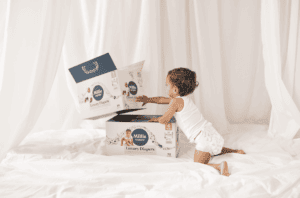For many of us, the pandemic slowed life down. It caused us to pause, reflect, and cherish the people in our lives. Some of us spent more time outside, reconnecting with nature. Others opted to dive into their bookshelves stocked full of best-sellers we kept buying and intending to read but hadn’t gotten around to. Most of us focused more on the family. But despite the lessons we may have learned, it also meant a lot of isolation for our children. The lack of in-person exposure and socialization translated to an increased reliance on digital connection, and shocking data shows that in the past two years, media use for tweens and teens grew faster than in the four years before the pandemic.1
A Common Sense Media study of time spent on screens by kids aged 8–18 found that between 2019 and 2021, the total amount of screen media used each day went from four hours and 44 minutes to five hours and 33 minutes among tweens, and from seven hours and 22 minutes to eight hours and 39 minutes among teens.2 That’s a 17% increase in the last two years — and it doesn’t include screen time while learning at school or doing homework.
Some have expected that a return to in-person school and regular extracurricular activities will reverse this trend, but that hasn’t happened so far. With kids filling up the empty minutes in their day on Snapchat, TikTok, YouTube, and Instagram, it’s easy to see why there’s less time to explore, spend time outside, and engage with friends and family in real life. Some parents feel powerless against the pull of ever-present technology, while others are concerned with long-term effects and are trying to challenge the status quo.
This is why parents are making the Wait Until 8th pledge.
What Is the Wait Until 8th Pledge?
Whether you’re looking for a way to bottle up your kid’s childhood just a little longer, or you are fearful of your child becoming disengaged, exposed to adult content, and addicted to their devices, you may be interested in making the Wait Until 8th pledge.
The Wait Until 8th pledge encourages parents to rally together to delay giving children a smartphone until at least 8th grade. The concept is simple: By signing the pledge, you promise not to give your child a smartphone until at least 8th grade as long as at least ten families total (from your child’s grade and school) pledge. Once ten families have pledged, you will be notified that the Wait Until 8th pledge is in effect, and Wait Until 8th will email you and the other parents to let you know the families on board to foster a sense of support and community. You can learn more about it here.
The Dangers of Children Having Smartphones Too Early
While there is no denying the various benefits and advances modern technology has afforded us, many parents are increasingly concerned with the long-term implications for their children’s developmental progress. A majority of parents surveyed by Pew Research say they are at least somewhat concerned about their child being the target of online predators, accessing sexually explicit and violent content online, or being bullied or harassed.3 Amid these worries, parents report that they monitor their young child’s digital activities in several ways, with most limiting screen time and using digital “grounding” as a disciplinary tactic. The American Academy of Pediatrics advises consistently limiting media consumption for children ages 6 and older.4
What Research Tells Us About Too Much Screen Time for Kids
Research from the University of Texas suggests the mere presence of a smartphone reduces cognitive capacity and test-taking brainpower.6 One study demonstrated that using smartphones in classrooms can even lower a student’s grade.7 Another study found that children who attend schools with smartphone bans did better on tests.8
Research funded by the National Institutes of Health says that, for young adults, heavy social media use is correlated with depression.9 The research was the first nationally representative study exploring the link between social media use and depression.
In Glow Kids, Dr. Nicholas Kardaras examines how technology has profoundly affected the brains of an entire generation. In his book, he dives into brain imaging research that shows how stimulating glowing screens are as dopaminergic (dopamine activating) to the brain’s pleasure center as sex. He also cites a growing mountain of clinical research (watch this video where Dr. Kardaras talks about this) that correlates screen tech with disorders like ADHD, addiction, anxiety, depression, increased aggression, and even psychosis.10
What Is the Ideal Age for Children To Have a Smartphone?
It’s not uncommon for kids to receive smartphones as early as first or second grade, but many experts say this is just too young.11 From child psychologists to internet safety leaders to technology executives, many agree that it’s best to wait until age 14 before giving kids access to their own smartphones. From a parental perspective, most parents don’t feel comfortable with giving kids under 12 smartphones; 45% say smartphone ownership is acceptable between the ages of 12 and 14, and 28% say it is acceptable between the ages of 15 and 17. Only 22% think it’s okay for a child under 12 to have one.5
Phone Alternatives To Get in Touch With Your Child
While the idea of living in a distraction-free world sounds nice, the reality is we all need ways to keep in touch with our kids before they enter 8th grade. The Wait Until 8th pledge suggests that parents consider buying their child a basic phone or a two-way calling watch as an alternative to a smartphone. The basic phone avoids many of the distractions and dangers of the smartphone while providing the necessities to stay connected. All the major carriers continue to offer basic cell phones that do not require data plans. One such device is Sprint’s WatchMeGo, a child-friendly phone for 5- to 12-year-olds that features GPS tracking and allows you to program specific incoming and outgoing numbers. It includes a string that can be pulled to set off a panic alarm.
How To Talk to Your Child About Smartphones
Like any topic that parents make taboo or off limits, kids tend to build more curiosity and interest, so it’s best to talk about the dangers and realities of smartphones. It’s also a best practice to be mindful of your own smartphone use in front of your children. If you’re adamant about limiting their exposure, take the time to reflect on your own smartphone habits. Cell phones have become intertwined with every part of daily life, from social connections to work to booking doctor’s appointments and paying bills. But if you’re constantly on your phone during quality time or at the dinner table, you’re sending mixed messages to your children about the importance of unplugging and being present.
Suggestions on How To Hold Off
It’s important to remember that the goal isn’t to avoid technology altogether but to promote responsible consumption and exposure to tech. Devices like a LeapFrog or Amazon Fire Kids Edition have been designed to engage with children specifically. Using applications like these, children can develop digital literacies responsibly, which may not be the case with technologies not designed with children’s development in mind, such as smartphones or other tablets.
Remember, there is power in turning off all screens together for 24 hours. A weekly practice can give your family more time, productivity, connection, and presence. Make it fun with a family game night, morning hike, or bike ride together.
Another option? Try filling your home with alternative activities and ways to connect as a family that spark creative conversation and learning. Former school teacher Kenny Ball created a monthly subscription service, Together Unplugged after he noticed a few disturbing trends in his classroom. The biggest issues were a clear decline in students’ abilities to focus and concentrate, the ever-persistent drama from social media that spilled over into the school setting, and hearing students talk about how infrequently their families interacted in the absence of smartphones and other screens.
What About Navigating Privacy Once Your Kids Do Have Smartphones?
To answer this, I will lend the advice of the very wise and articulate Glennon Doyle. The author and mother of three describes navigating and keeping her (then) tween son safe on the internet. While checking his texts and Instagram account, her son turned to her and said, “Mom. When am I going to have some privacy on that thing?”
Her response was a perfect combination of analogies our kids can appreciate and parenting wisdom that begs to be repeated.
“Well, honey. Requesting privacy on the internet is sort of like requesting privacy in the middle of a baseball stadium during the World Series. Both the internet and baseball stadiums are—by very definition—very public places. If you say things on the internet or in a baseball stadium, people are free to hear those things. Your mother is one of the people who are free to hear. This is true for many reasons—not the least of which is that she has undoubtedly purchased your tickets to both the internet and the baseball stadium.
It is understandable that you need privacy in your life, honey. Some examples of private spaces are, for example—the bathroom. Or inside your brain. Or even behind the closed door of your bedroom. I don’t have my own bedroom like you do, so I don’t know how that kind of privacy must feel—but I’m not bitter about that. Let’s stay on track here. What I’m suggesting is that when you need privacy for your thoughts, perhaps think them in your head. Or go into your room and write them down inside a diary. I promise never to read your diary. A diary is private. The internet is public. Different things.”































